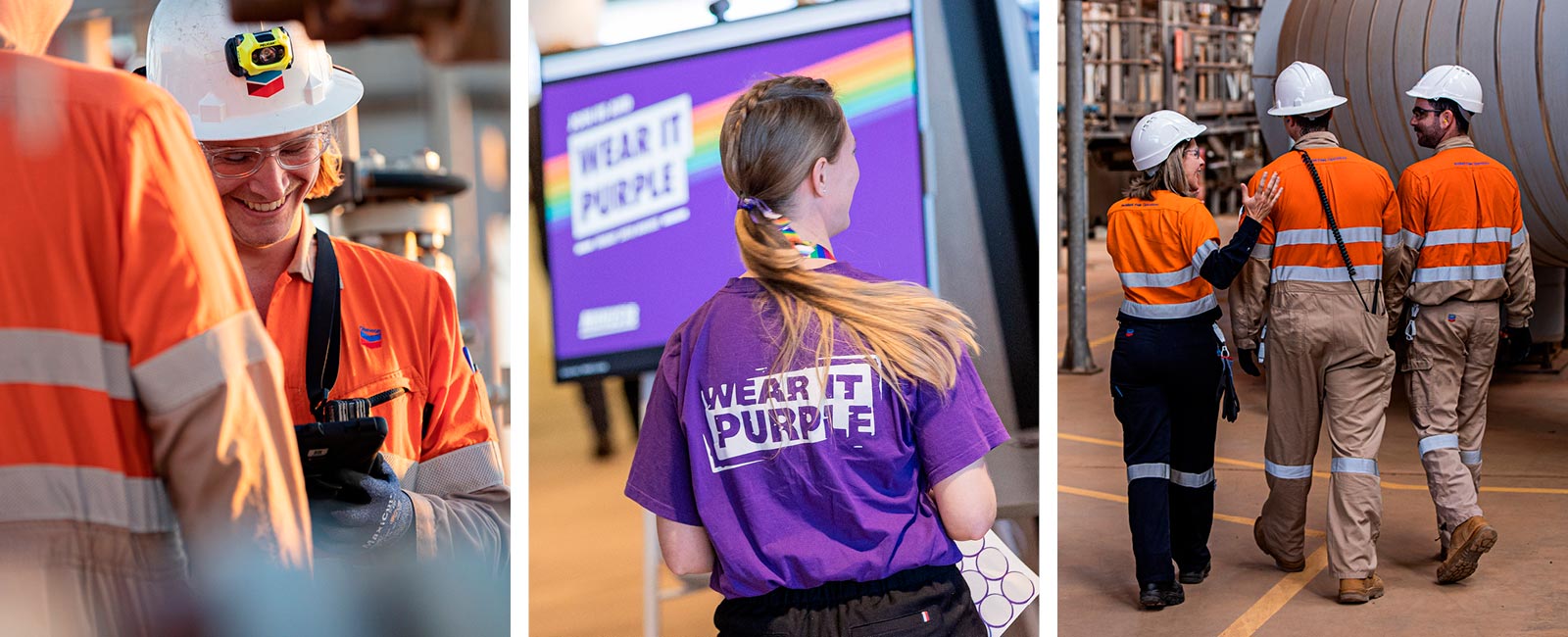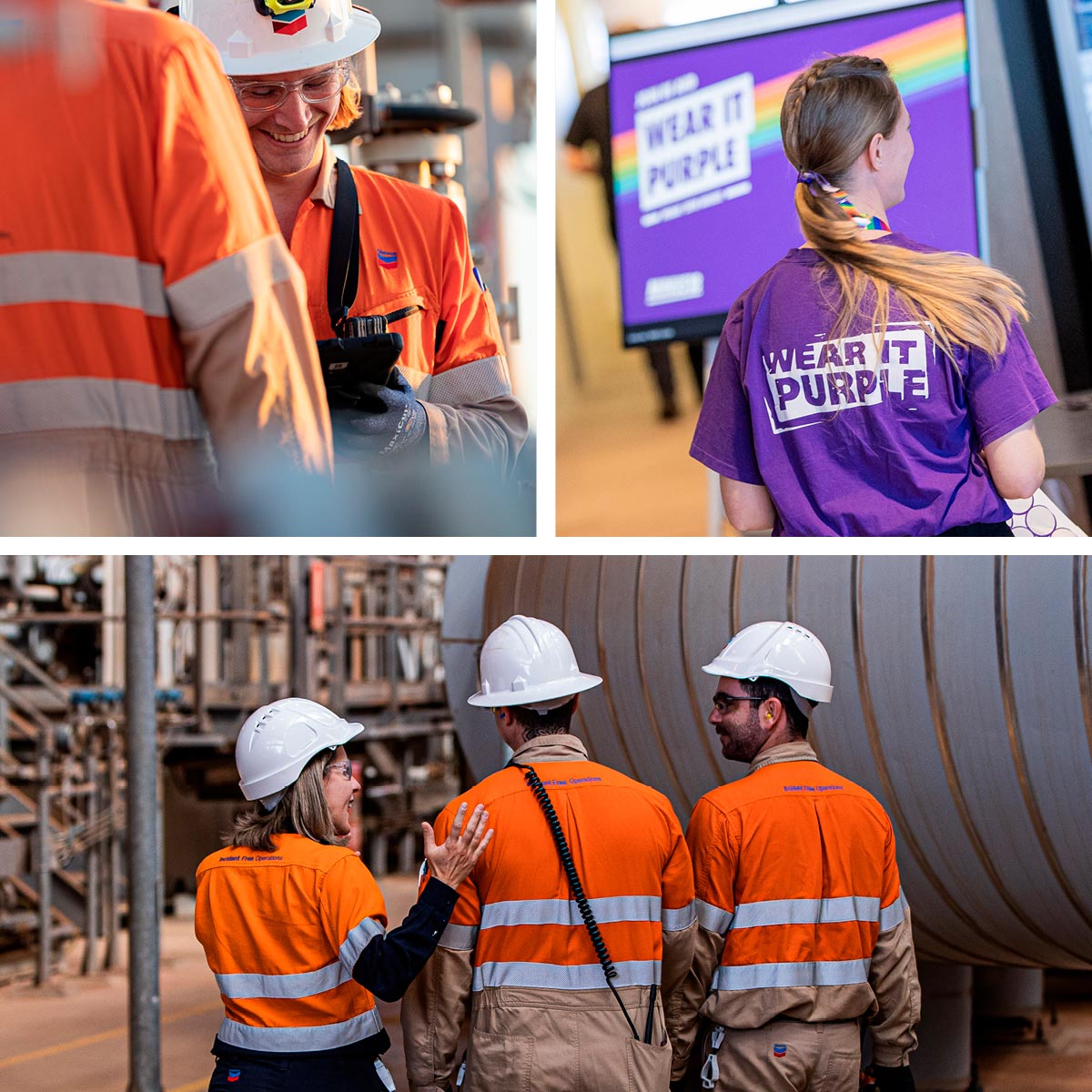

our commitment
ensuring a safe, respectful and inclusive workplace
Putting our people first and ensuring a safe, respectful and inclusive workplace is critical to our success as individuals and as an organisation.
In accordance with the Chevron Way – which provides a foundation for what we value, what we believe and how we behave – our goal is to have a diverse and inclusive work environment that values the uniqueness and diversity of individual talents, experiences and ideas.
We’re committed to listening, learning and identifying practical steps to ensure:
- our workplaces value diversity and provide a safe, inclusive and respectful environment for all to fully participate;
- we have appropriate policies, procedures and practical measures in place to protect our people and prevent bullying, harassment, and discrimination;
- any instance of bullying, harassment or discrimination can be reported and addressed; and
- individual safety and procedural fairness are at the forefront of any investigation or other action taken.
Our expectations about workplace behaviour are made clear in our Business Conduct and Ethics Code and company policies.
We require everyone in our workplaces to treat their colleagues with respect and we will not tolerate unlawful discrimination or inappropriate behaviour including bullying, harassment, and retaliation.
chevron australia's safe, respectful and inclusive workplace review
Chevron Australia has a vision for a workplace where safe, respectful and inclusive behaviours are deeply ingrained in our culture, and we’re committed to taking action to address inappropriate workplace behaviour.
In November 2022, we released the outcomes of the Safe, Respectful and Inclusive Workplace Review – a voluntary, independent review undertaken by external consultancy Intersection, aimed at understanding the prevalence of inappropriate or harmful behaviours in Chevron Australia workplaces.
The review found that bullying, harassment and discrimination occur in our workplaces and not everyone feels confident in reporting these incidents through the various channels available.
Twenty-four recommendations were made across four key focus areas:
- addressing the prevalence of bullying, harassment (physical, verbal and sexual) and discrimination;
- uplifting leadership accountability;
- increasing diversity, equity and inclusion; and
- improving the response to reports of inappropriate behaviours.
Detailed findings and recommendations can be found in the full Workplace Review Report and the Executive Summary.
our response
Chevron Australia is determined to take meaningful action to address the findings and implement the recommendations of the Safe, Respectful and Inclusive Workplace Review.
With the support of a dedicated team, we’re progressing efforts to address the presence of inappropriate behaviours in our workplaces and drive the change that is needed so our workplaces are safe, respectful and inclusive for everyone.
Actions taken to address the recommendations and deliver on Chevron Australia’s commitment to ensure a safe, respectful and inclusive workplace include:
better learning series
increased transparency
updated discrimination, harassment & bullying policy
stand-alone sexual harassment policy
internal strategic review
increased team resourcing
facilitated upstander training
new stand up to bullying training
Chevron Australia remains focused on driving lasting and impactful cultural change.
This journey is ongoing and there will always be opportunities to learn, improve and evolve.
We will continue to engage with our workforce to build knowledge, encourage leadership and accountability and deliver on our commitment to ensure a safe, respectful and inclusive workplace.
diversity and inclusion
Diversity and inclusion is a Chevron Way value. Research demonstrates that embracing workforce diversity not only enhances business and safety performance and fosters innovation, but also mitigates against the occurrence of unsafe and disrespectful behaviours.
Fostering a diverse and inclusive workplace, that reflects the broader community in which we live and work, is imperative to attracting and retaining talent – which we need in order to deliver sustainable, long-term performance and profitability.
Improving gender equity and closing the gender pay gap are key aspects to creating an inclusive environment that embraces individuality and recognises the benefits of our unique differences.
We are on a journey to ensure a diverse and inclusive work experience for all.
Gender equity is the process of ensuring fairness to both men and women, recognising that people have inherently different experiences and access to benefits, power, resources and responsibilities as a result of their gender or how they wish to be identified.
To accommodate for these inherent differences, and to strive for fairness, purposeful and targeted strategies must be in place.
Currently, women make up 25 per cent of the Chevron Australia workforce.
Chevron Australia is committed to taking action to increase gender equity within our business.
increasing female representation
year-on-year
- across the organisation
- across target pay grades
50:50
gender balance
- in all education to employment and early career recruitment
- in all qualified external candidates shortlisted to interview
At least 30% female representation across all Personnel Development Committees (PDCs)
A requirement for all PDC discussions to include an identified Inclusion Counsellor
Recruitment selection panels have at least 30% female representation as well as an identified Inclusion Counsellor
In addition, we have supporting systems, policies, training and initiatives to assist in the achievement of these goals including:
- Robust compensation systems and processes to ensure we pay employees comparably for similar work.
- Improving data collection and demographic dashboards to provide leaders with greater insights to guide actions.
- Continuing to educate Personnel Development Committee (PDC) members and the workforce on inclusive behaviours including – unconscious bias training, the Better leader series, Upstander training, Stand up to Bullying training, cultural awareness training and encouraging safe, respectful and inclusive behaviours PMP goals.
- Flexibility through our parental leave policy and supporting toolkits, flexible work arrangements that include our hybrid work model, compressed work week schedule, varying start and finish times as well as increased job share or part time opportunities.
- Ensuring our policies are simple, clear and use inclusive language including our Flexible Work Arrangements Policy, Discrimination, Harassment and Bullying Policy and Sexual Harassment Policy.
- Helping to build out a diverse talent pipeline for our industry through education and science, technology, engineering and maths (STEM) partnerships such as our Women in Engineering program and the Stars Foundation program.
- Supporting diversity and inclusion employee networks across our organisation that foster engagement and connection.
- Supporting employees in their career progression through our PDC processes.
Through commitment and intentional action, we aim to foster an environment and culture where all our people enjoy the same opportunity, rights, responsibilities, and respect regardless of their gender.
Improving gender equity and closing the gender pay gap are key aspects to creating an inclusive environment that embraces individuality and recognises the benefits of our unique differences.
Chevron Australia understands the importance of ensuring there is transparency and accountability around the gender pay gap and welcomes the opportunity to share its Gender Pay Gap Report for 2024/2025.
In accordance with legislative requirements, this data has been provided to the Workplace Gender Equality Agency.
Addressing the imbalance and supporting the advancement of women is consistent with our vision and long-standing commitment to the Chevron Way value of diversity and inclusion and will enable our company to deliver superior performance, profitability and innovation.
definitions
Bullying: repeatedly unreasonable behaviour by an individual or a group of individuals towards another individual, where the behaviour creates a risk to health and safety. Examples of bullying include behaving aggressively towards others, teasing or playing practical jokes, pressuring someone to behave inappropriately, excluding someone from work-related events, repeated unjustified criticism of someone’s work and making unreasonable work demands.
Chevron Australia means Chevron Australia Pty Ltd. The workplace review conducted by Intersection considered Chevron Australia’s upstream workplaces only and did not include workplaces related to the Chevron Australia Downstream business or Puma or Caltex brands.
Discriminatory behaviours: Direct discrimination occurs when someone is treated unfavourably because of a personal characteristic such as age, sex, gender identity, race or disability. Indirect discrimination occurs when a requirement that appears to be neutral and the same for everyone in fact has the effect of disadvantaging someone with a personal characteristic protected by law, such as age, sex, gender identity, race or disability.
Harassment covers a wide range of behaviours that are offensive in nature. It is commonly understood as behaviour that is demeaning, humiliating or embarrassing to someone.
Inclusion Counsellor: the role of the Inclusion Counsellor is to provide perspective outside of the function or business unit to the selection team to check against unconscious biases that may interfere with people decisions. They also encourage more complete thinking and will ensure that there is a robust, bias-free discussion.
Personnel Development Committee (PDC) performs strategic activities that support the development of a skilled, competent and qualified workforce.
Sexual harassment: an unwelcome sexual advance, unwelcome request for sexual favours or other unwelcome conduct of a sexual nature which, in the circumstances, a reasonable person, aware of those circumstances, would anticipate the possibility that the person would feel offended, humiliated or intimidated. Behaviours that can constitute sexual harassment are varied and can often get labelled as “joking” or “banter”. Examples of sexually harassing behaviour include unwelcome touching, staring or leering, suggestive comments or jokes, sexually explicit pictures or posters, unwanted invitations to go out on dates, requests for sex, intrusive questions about a person's private life or body, unnecessary familiarity (such as deliberately brushing up against a person), insults or taunts based on sex, sexually explicit physical contact, and sexually explicit emails or SMS text messages.